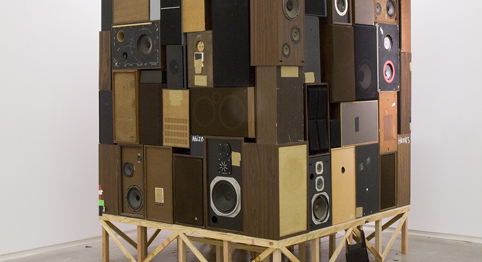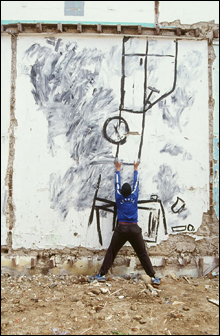Bad-boy cool‘Street Level’ at the ICA, plus Ranjani Shettar and David Claerbout March 24,
2008 2:24:18 PM

ORADORES, ORADORES, ORADORES: William Cordova’s sculpture is the Kaaba at Mecca, the
monolith from 2001, and a thrift-store storage room rolled into one.
|
“Street Level: Mark Bradford, William Cordova and Robin Rhode” and “Momentum 10: Ranjani Shettar”
Institute of Contemporary Art, 100 Northern Blvd, Boston | Through July 13
“David Claerbout” | MIT List Visual Arts Center, 20 Ames St, Cambridge | Through April 6
|
“People look at an oil painting and admire the use of brushstrokes to convey meaning. People look at a graffiti painting and admire the use of a drainpipe to gain access.” That according to infamous British graffiti artist Banksy — probably our most popular living artist after QVC huckster Thomas Kinkade.
In a world that seems ever more synthetic and controlling, street art poses as a guerrilla force pushing back. Its rascally, outlaw, bad-boy cool feels free, real. Our postmodern (or maybe early post-postmodern) art world suffers from its own artificiality complex. So it mines urban style for authenticity, for energy, for street cred. Which brings us to “Street Level,” the fun, hip new exhibit organized by Duke University’s Nasher Museum and now up at the Institute of Contemporary Art, with work by Mark Bradford, William Cordova, and Robin Rhode.
The South Africa–born, Berlin-based Rhode seems to enter into the chalk-and-oil stick drawings that he graffitis onto walls and streets like a hip-hop Harold and the Purple Crayon. In his lyrical 2005 video Untitled, Harvest, we watch a series of still shots of Rhode planting (chalk) seeds and watering them. They sprout wavy chalk lines with dots on top that he mows down with a scythe. They sprout again forming a bed frame, and he lies down under a real sheet — maybe just a sleeping man or maybe a corpse under a shroud. In his 2004 video He Got Game, Rhode sketches a basketball hoop with chalk on pavement and then seems to leap, somersault, and dunk a real basketball. The magic is in his held poses, which feel like frozen frames of action, and in the framing. The camera looks down at the ground, but we feel that we’re looking across at a wall, so though Rhode is lying on the ground, he seems to be flying through the air.
Los Angeles artist Mark Bradford collects posters from city walls and fences and pastes them into giant collages. Europeans like Mimmo Rotella made stuff like this in the ’60s, but Rotella tended to retain the posters’ imagery, whereas Bradford often creates abstract patterns that recall maps of cities. Temporary (2005) is a billboard-sized expanse of white paper dotted with asymmetrical urban-like grids of pink, black, and gray paper or tape with red yarn lines circulating through. Bradford often layers paper over yarn and then tears, sands, and scrapes it down, making his surfaces seductively ragged and worn, like the patchwork layers of posters you see pasted around cities. His art has the grandeur and gritty nostalgia of shuttered mills and abandoned buildings — our modern ruins.

UNTITLED DREAM HOUSES: Robin Rhode
seems to enter into the chalk-and-oil stick
drawings that he graffitis onto walls and streets.
|
The Peru-born, Houston-based William Cordova makes drawings, collages, sculptures and videos often featuring graffiti and strange accumulations of tires, stereo speakers, shoes, or bottles. His drawings here are okay, but his Oradores, Oradores, Oradores (p’a Audrea Jones, Ana Maria Rodriguez y Betsy Tregar) (2007-’08) is a striking block of more than 100 stacked-up old stereo speakers set on a wood platform and surrounded by bits of broken wood and shattered records. It looks like a monument or crypt, like the Kaaba at Mecca, the monolith from 2001: A Space Odyssey, and a thrift-store storage room rolled into one. Peering through gaps between the speakers, you find the structure is hollow, and set inside are Santana albums, Toni Morrison’s book Sula, a book on Pinochet’s oppressive regime in Chile, and a record of a speech by Adam Clayton Powell. Walk around to the back corner of the sculpture and you find that the speakers are stacked lower and painted with names: Seale, Newton, Mao, Chavez, Cleaver. The people mentioned in the title are among these names: Jones was a leader of a Boston Black Panther branch in the ’70s; Rodriguez and Tregar were teachers who formed the Roxbury social-service organization La Alianza Hispana in 1968. (The art world has ’60s nostalgia bad these days, as if everyone were looking back for some good old activist days because today’s troubles are too scary to engage directly.)
All these people — activists and radicals — are either old or dead. “Oradores” is Spanish for “orators,” and there’s the double meaning in English of “speakers” as both orators and stereo equipment (stereo speaker being “altavoz” in Spanish). The dead speakers are a wall of sound that has been silenced. But Cordova also seems to be punning on “orar,” Spanish for “to pray” — turning the sculpture into a shrine while suggesting what options we’re left with.
|
 |

|
- How Herald publisher Pat Purcell could pitch inside — and brush back the Globe
- Reconciling the irreconcilable
- The wars of evolution are louder than ever. What Ben Stein, Bad Religion, and a physics professor from Quincy can tell you about where you came from.
- Win or lose, Obama's small donors may have already brought a revolution in campaign financing
- Israeli magic realism
- Some Things at Trinity
- How Herald publisher Pat Purcell could pitch inside — and brush back the Globe
- Nancy Goldner on Mr. B
- Swan Lake in Boston and Providence
- Dolly Parton rolls out the big guns
- Keep your hands on the pole and not on your neighbor’s ass, bucko.
- The wars of evolution are louder than ever. What Ben Stein, Bad Religion, and a physics professor from Quincy can tell you about where you came from.
|
-
The high voltage work of Corita Kent
-
Walid Raad’s installations seek the “truth”
-
Compelling new work by Neal T. Walsh and William Schaff
-
Malcolm Grear at RIC; plus, Roger Mayer’s ‘Soundless’
-
A local collective subverts with the tiny
-
Shake-ups on the gallery scene
-
The RISD Museum showcases ‘Stryrofoam’
-
Art on the move
-
New exhits at the Stairwell, Bannister, and URI galleries
|

- The peculiar American brashness of George Bellows
- Walid Raad’s installations seek the “truth”
- The DeCordova Annual, New Orleans after Katrina, ‘Superartificial,’ 19th-Century Leisure Travel, and El Chango Verde
- ‘Alexis Rockman,’ ‘The New Authentics,’ and ‘Paper Trail II’ at the Rose, and Chantal Akerman at MIT
- Compelling new work by Neal T. Walsh and William Schaff
- ‘El Greco to Velázquez’ at the MFA
- ‘Wedded Bliss’ at the Peabody Essex, Toys and Games at the Revolving Museum, and Chad Walker at Space 242
- The mature art of longtime Maine artists
- Malcolm Grear at RIC; plus, Roger Mayer’s ‘Soundless’
- A local collective subverts with the tiny
|
|